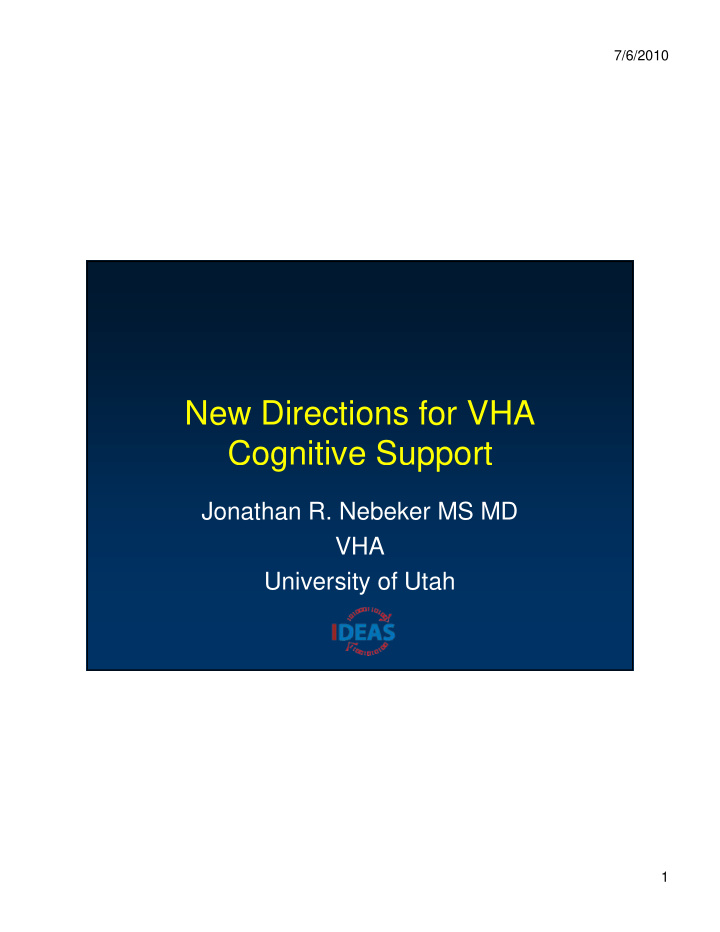



7/6/2010 New Directions for VHA Cognitive Support g pp Jonathan R. Nebeker MS MD VHA University of Utah 1
7/6/2010 Acknowledgements • Scientific team – Charlene Weir – Frank Drews – Bruce Bray Bruce Bray • Operations Team – Patient Care Services Medical Informatics – Paul Nichol Paul Nichol • Funding – AHRQ 2
7/6/2010 VA EHR Way Forward • A renaissance? • Modular extensible architecture? • Open source community? • Value behavioral sciences? 3
7/6/2010 Decision vs. Cognitive Support • Decision support – Here’s the right decision/task – Sometimes consider Workflow – Rarely consider Cognition Rarely consider Cognition • Cognitive support – Give rich information environment that supports cognition in context of problem and pp g p workflow 4
7/6/2010 Translating frameworks for Cognitive Support • Moving away from – Paper-based-chart metaphor (13 years) – Event-driven decision support – Human factors as usability analysis Human factors as usability analysis • Moving towards – Information rich environments – Cognitive Systems Engineering Cognitive Systems Engineering • Using theory to inform design 5
7/6/2010 Theoretical Foundation • Cognitive System Engineering – Joint Cognitive Systems – Contextual Control Model • Mindsets & Goal pursuits Mi d t & G l it 6
7/6/2010 Contextual Control Model 7
7/6/2010 Control Characteristics • Breadth – Time – Data space • Relationships (complexity) R l ti hi ( l it ) – What is related – Implications of relationships • Adapting to uncertainty and unusual • Adapting to uncertainty and unusual – Data gathering strategies – Decision-making strategies 8
7/6/2010 COCOM + Action Phases 9
7/6/2010 CCOCM + Mindsets Updating (Breadth) Planning Sensmaking (Complexity and Uncertainty) 10
7/6/2010 Goals • Reduce cognitive load (make it easier) to: – Consider breadths of data – Complexity of relationships – Deal with uncertainty Deal with uncertainty • Improve shared cognition – Targets clinicians and teams • Facilitate mindset transitions and focus on • Facilitate mindset transitions and focus on appropriate goals 11
7/6/2010 New EHR Paradigm • Reduce to basic concepts – Conditions, Interventions, Observations • Annotate observations • Relate – Terminologies, Knowledge bases, Ad hoc 12
7/6/2010 Example of Integrated Control 13 13
7/6/2010 Status and Goals 14
7/6/2010 Design Principles • Maximize ease of attaining high levels of control characteristics. – Breath, relationships, decision strategies • Make information present or rapidly Make information present or rapidly accessible (for rapid cognitive cycling) • At each step, ask what information is needed for task and mindset needed for task and mindset. • Not “only right information at right time” 15
7/6/2010 16 16
7/6/2010 Integrated Documentation & Quality Measurement • Update observations • Orders write plan • Plan satisfied quality measures • Assistance from terminology – NDF-RT – Clinical Enterprise Terminology 17
7/6/2010 18 18
7/6/2010 Planning • Medication reconciliation in context – Change in medications – Conditions (acute and chronic), – Status of conditions (observations) Status of conditions (observations) • Feed forward control 19 19
7/6/2010 20
7/6/2010 Access to Free Text • Need to break up documentation and link to key concepts. • Allows focus on one one type of information across time information across time. 21
7/6/2010 Demo 22
Recommend
More recommend